Are you serious about building a big, massive, and strong back? It might be time to employ the bent-over barbell row regularly in your training and train as harder as you can. Train back at least once per week and go heavy as possible you can, to build the desired results.
You won’t do much better than the bent-over barbell row when it comes to gaining back strength and size. Better yet, the strength you gain from rowing a heavy barbell in a hinged position carries over to the strength movements you love to do (squats, deadlifts, and other rows). You’ll also take your core and grip strength up a notch or three (but more on that below).
Ok, ready to learn the ways of the bent-over barbell row for new gains? Sure you are. Read up below for a step-by-step instructional on how to do the movement, plus variations, alternatives and benefits explained.
Bent-Over Barbell Row
How to Do the Bent-Over Barbell Row
Below is a step-by-step guide on how to perform the bent-over barbell row using a barbell. You can do this move with an underhand grip (palms facing your head), and all of the steps below still apply. Also, try to avoid using lifting straps at first. Your grip is a limiting factor in how much weight you can row, so it makes sense to wear them for your heavier sets. That said, you can strengthen your grip during your ramp-up sets by keeping the straps in your gym bag.
Step 1 — Grip the Bar, Set the Back
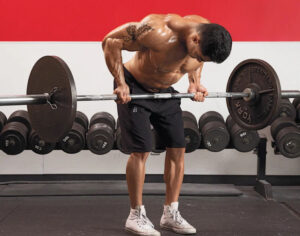
Set up for the bent-over barbell row just like you would for a deadlift, but place your hands a bit wider. They should be about shoulder-width apart. Drop your hips, straighten your back, and lockout your elbows. Lif the barbell off the floor so you’re hinged over about 45 degrees, and the barbell is resting right in front of your thighs.
Form Tip: Find the stance that feels most comfortable and allows you to maintain a strong hip hinge position and tense back.
Step 2 — Initiate the Row
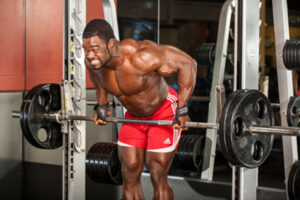
Squeeze your abs and row the barbell to your belly button. Be sure to lead the row with your elbows. Keep your shoulders down, and squeeze the shoulder blades together at the apex of the movement to engage your upper back muscles.
Form Tip: If the weight is causing you to drop your chest or the elbows are flaring, then reduce the load on the bar.
Step 3 — Flex the Back, then Lower the Weight
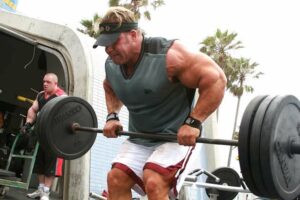
After you’ve held the top portion of the bent-over barbell row for a beat, lower the weight with control. You don’t need to spend three seconds returning to the start position, but don’t let the bar drop back to in front of your thighs.
Form Tip: If you want to build muscle, you can pause at the top of the movement or lower the bar to a slow tempo. This pause and/or eccentric rep will create a lot more time under tension.
The Benefits of the Bent-Over Barbell Row
If you don’t know, now you know. Here are the main benefits you can expect from adding the bent-over barbell row into your routine.
Upper Back Hypertrophy and Strength
A big back signals to the rest of the world that you lift. Thick lats and traps that jut out of a large t-shirt look, admittedly, pretty bad-ass — and it’s ok to want to look like you lift. Beyond aesthetics, a big back can improve your lifts. Along the way, your back will get stronger, and a stronger back can brace harder for more spinal stability during movements like the squat and deadlift. A thick back also provides a base from which you can perform horizontal presses such as the bench press and dumbbell press.
The bent-over barbell row, specifically with a barbell, is one of the best strength- and muscle-building movements. It allows the lifter to use more weight relative to other rowing movements. It also recruits the forearm and biceps muscles, which leads to a stronger grip. Lastly, the core is more engaged as it’s constantly supporting a bent-over position and rigid torso.
Application to Deadlifts and Pulling Movements
As the name implies, the bent-over barbell row has the lifter maintain a hinged position for the movement’s duration. Maintaining a hip hinge while rowing weights forces the core and the lower back muscles to activate for the entire set. The hamstring and hips are engaged, too. Combined, all of those muscles are active during a deadlift, so you’re essentially training them to get stronger in a deadlift position while building up your back.
In short: the bent-over barbell row will enhance the stability and durability of the muscles needed during deadlifts and other similar pulling movements.
Postural Strength and Control
Without proper strength, stability, and awareness of one’s body in space and the ability to resist lumbar flexion (spinal rounding), the athlete may find themselves in compromised positions resulting in injury or lackluster performance.
Movements like the bent-over barbell row help increase the back (upper and lower) strength and reinforce proper spinal control and resistance to lumbar flexion under load.
Muscles Worked by the Bent-Over Barbell Row
The bent-over barbell row is a compound movement, which means it involves the movement of two or more joints. It also calls upon the muscles in the back, but also secondary muscles such as the biceps. Here’s a full breakdown of the muscles utilized in the bent-over barbell row.
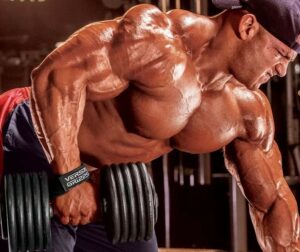
Latissimus Dorsi (Back)
The lats are a large triangular muscle that spans the entire length of your back. A strong back helps you in nearly every single endeavor as a lifter. Stronger back muscles also let you maintain better posture.
Spinal Erectors (Lower Back)
The spinal erectors help stabilize the spine during this bent-over barbell row, as you’re hinged for the entire movement, and a strong lower back is necessary for nearly every lift.
Hamstrings
The hamstrings work isometrically to support the lifter as they assume the bent-over position (similar to the erectors). When done correctly, the lifter should feel an intense stretch being placed on the hamstrings. The hamstrings work isometrically to support the lifter and aid in setting the back during the bent-over barbell row.
Scapular Stabilizers
Your scapulas, or shoulder blades, allow you to retract and protract your shoulders. Simply put, they let you squeeze your back muscles. These small muscles are engaged entirely during the bent-over barbell row as your squeeze and relax your shoulder blades during each rep.
Who Should Do the Bent Over Barbell Row?
Below are some reasons why strength, power, and fitness athletes can benefit from performing bent over rows.
Strength and Power Athletes
- Powerlifters and Strongmen/Strongwomen: Bent over rows are a great movement to increase back strength and muscle growth. Movements like the deadlift, squat, bench press, loaded carries, and overhead lifts all require a strong back, making the bent-over barbell row an excellent accessory exercise for all strength athletes.
- Olympic Weightlifters: Olympic weightlifters can use the bent-over barbell row to increase back strength and muscle growth. A strong back is key for movements like pulls, squats, and proper positioning in the overhead squat and jerk. Movements like the bent-over barbell row, Romanian deadlift, and Pendlay row are all great ways also to increase positional back strength necessary for snatches and cleans (pulling position).
Fitness Athletes and the General Population
The same benefits that apply to strength athletes — more back strength, muscle, and stability — apply to fitness athletes and everyday gym-goers. A CrossFitter, for example, will be able to bang out more chest-to-bar pull-ups with a stronger back and experience less lower-back fatigue during high-rep clean & jerks.
Bent-Over Barbell Row Sets, Reps, and Programming Recommendations
Here are some basic suggestions for how to add the bent-over barbell row into your workout routine. Remember that these are just suggestions based on goals, and you can alter them as you see fit.
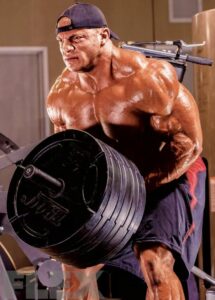
To Gain Muscle
To gain muscle, you’ll want to use a moderate load and aim to accumulate more volume than you would if you were focusing on strength. Do three to five sets of five to 10 reps with a moderate to heavy load, OR two to four sets of 10-20 reps with moderate loads to near failure.
To Gain Strength
For strength, perform three to five sets of three to five repetitions with heavy loading. Rest as needed. Generally, heavy bent-over barbell rows should be reserved for more experienced lifters. Maintaining a hinge while supporting a heavy barbell can really strain the back. You can try Pendlay rows, which are better suited for strength-building.
To Improve Muscle Endurance
If you’re looking to accumulate muscular endurance and conditioning, you should aim for high reps using less weight. Start with two to three sets of 20-30 repetitions with 45-60 second rest with light to moderate loads.
Bent-Over Barbell Row Variations
Want to ditch the barbell? That’s cool. Here are two bent-over barbell row variations you can sub in instead.

Dumbbell Bent-Over Row
By swapping a barbell for dumbbells, the lifter can better manipulate the pronation/supination of the wrist to target slightly different angles and muscles in the back/posterior shoulder. This can help address muscle imbalances and allow for a longer range of motion to the bent-over barbell row. You can perform this movement with one or two dumbbells (as shown below).
Kettlebell Bent-Over Row
Same movement, different tools. By using kettlebells, a weight that has an offset center of gravity, you’ll be able to elicit a different “feel.” Also, the thick cast-iron handle will do wonders for your grip strength.
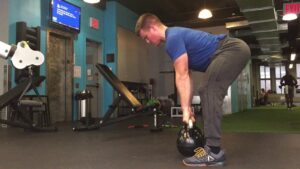
Bent-Over Barbell Row Alternatives
Below are three bent-over barbell row alternatives that can be done to increase strength and hypertrophy for more program variety.
Pendlay Row
This rowing variation is nearly identical to the bent-over barbell row except that you rest the weight on the ground after each rep. Because you’re resting the load on the ground briefly between sets, you force proper positioning and minimize momentum, which also increases concentric strength off the floor.
This helps increase strength in the back for movements like deadlifts and cleans and for beginners who may not be able to sustain proper rowing form in a hinge position.
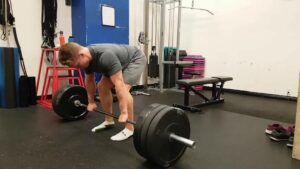
Seal Row
The seal row is a row variation with a lifter lying prone on a bench while holding weights and performing supported rows. By lying on the bench, you minimize any stress and tension of the lower back and hamstrings. This is a great variation to isolate the back and minimize momentum or bouncing during the row.

Chest-Supported Row
This is a great option for lifters who want to minimize strain and stress on the hamstrings, lower back, and body while training the back. For example, lifters with sore/stiff hamstrings or lower backs (let’s say after deadlifts or squats) may find that doing higher rep or heavier loaded rows in a supported position allows them to train the back and isolate those muscles without being limited by hamstrings and lower-back fatigue.

FAQs
What muscles does the barbell row work?
Muscle activation will vary slightly depending on the row variation being performed. The following muscles are trained as prime movers with the traditional barbell row:
On top of these muscles, the barbell row will also train synergist and stabilizer muscles like the erector spinae, supraspinatus, infraspinatus, and many more.
Can beginners barbell row?
Yes. Beginners are perfectly fine performing barbell rows on a regular basis. Like every compound movement, the barbell row can benefit from being first learned under the watchful eye of a coach.
What are good barbell row progressions?
A couple of good barbell row progressions worth trying are the dumbbell row and the seal row. The dumbbell row is a great progression that everyone can implement in nearly any gym setting, while the seal row can be a great progression for learning lat contraction without spinal loading.
What are the differences between the dumbbell and barbell row?
One major difference between these two rows is that the dumbbell row is a unilateral exercise (one side of the body) and the barbell row is a bilateral exercise. Also, each movement will activate the core slightly differently. In a 2015 study published in the International Journal of Sports Medicine, the authors suggested that the dumbbell row was slightly better at activating the external oblique than the barbell row. (1)
How high should I row the barbell to the chest?
It’ll vary based on body type, but a good rule of thumb is to row the barbell to your belly button. Remember to squeeze your shoulder blades together for each rep.
What should you do if I can’t keep my back flat during a bent-over barbell row?
Rounding your back during a bent-over row is potentially dangerous. The easiest way to ensure your back stays rigid is to lower the load. Otherwise, you’ll compensate by rounding your spine, and that’s a no-no.
Can I use a little body English during my bent-over rows?
Typically, no. The main goal of a bent-over barbell row is to target the back muscles for strength and size. For that, you need tension, and momentum will kill that tension. So, keep your reps slow and controlled. That said, if you are at the end of a set, and use a little momentum to sneak out a few more reps, then that’s OK as long as you still feel your back muscles working.
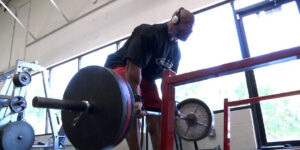
For more news and updates, follow IFBNewsfeed.Org on Facebook, Twitter, and Instagram.






